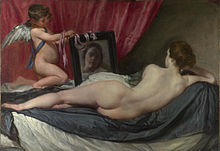- Mary Richardson
-
This article is about the suffragette. For the painter, see Mary Curtis Richardson.
Mary Raleigh Richardson (1889 – November 7, 1961) was a Canadian suffragette active in the women's suffrage movement in the United Kingdom and later the head of the women's section of British Union of Fascists (BUF) led by Sir Oswald Mosley.
Contents
Militant actions
At the beginning of the 20th century, the suffragette movement, frustrated by a failure to achieve parliamentary reforms, began adopting increasingly militant tactics. In particular, the Women's Social and Political Union (WSPU), led by the charismatic Emmeline Pankhurst, frequently endorsed the use of property destruction to bring attention to the issue of women's suffrage. Richardson was a devoted supporter of Pankhurst and a member of the WSPU.
Slashing the Rokeby Venus
Richardson's most famous act of defiance occurred on March 10, 1914 when she entered the National Gallery in London and slashed the Rokeby Venus with a chopper she smuggled into the gallery.[1]
She wrote a brief statement explaining her actions to the WSPU which was immediately printed by the press:[2]
"I have tried to destroy the picture of the most beautiful woman in mythological history as a protest against the Government for destroying Mrs Pankhurst, who is the most beautiful character in modern history. Justice is an element of beauty as much as colour and outline on canvas. Mrs Pankhurst seeks to procure justice for womanhood, and for this she is being slowly murdered by a Government of Iscariot politicians. If there is an outcry against my deed, let every one remember that such an outcry is an hypocrisy so long as they allow the destruction of Mrs Pankhurst and other beautiful living women, and that until the public cease to countenance human destruction the stones cast against me for the destruction of this picture are each an evidence against them of artistic as well as moral and political humbug and hypocrisy."[3]
As a Fascist
Richardson like a number of middle- and upper-class suffragettes turned to fascism. She became the head of the Women's section of the British Union of Fascists BUF.[4]. Two other prominent suffragette leaders to gain high office in the BUF were Norah Elam and Commandant Mary Allen.[5].
Later life
Richardson published her autobiography, Laugh a Defiance, in 1953. She died at her flat in Hastings on November 7, 1961.
See also
References
- ^ BBC Radio 4 - Woman's Hour - Women's History Timeline: 1910 - 1919
- ^ Gamboni, The Destruction of Art, p. 94.
- ^ "Miss Richardson's Statement". The Times. 11 March 1914.
- ^ http://www.bbc.co.uk/iplayer/episode/b00pk7zp/Mother_Was_A_Blackshirt/?from=r&id=35227e69-fcbf-45d7-8295-2c78e9703b74.0
- ^ McPherson, Angela; McPherson, Susan (2011). Mosley's Old Suffragette - A Biography of Norah Elam. ISBN 978-1-4466-9967-6. http://www.oldsuffragette.co.uk.
Bibliography
- Gamboni, Dario. The Destruction of Art: Iconoclasm and Vandalism since the French Revolution. Reaktion Books - Picturing History, 2007. ISBN 1861893167
- Nead, Lynda. The Female Nude: Art, Obscenity, and Sexuality. Routledge, 1992. ISBN 0415026776
- Prater, Andreas. Venus at Her Mirror: Velázquez and the Art of Nude Painting. Prestel, 2002. ISBN 3791327836
Categories:- 1889 births
- 1961 deaths
- Vandals of property
- British fascists
- Canadian fascists
- British suffragists
- Canadian suffragists
- Women of the Victorian era
- People of the Edwardian era
Wikimedia Foundation. 2010.

